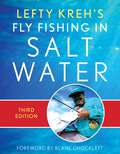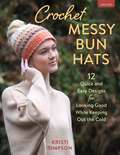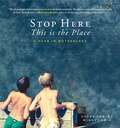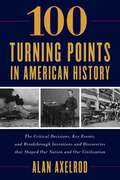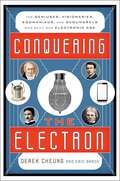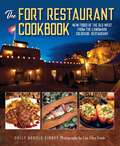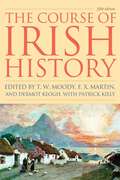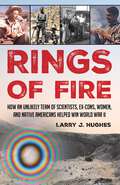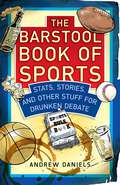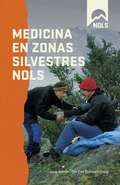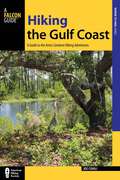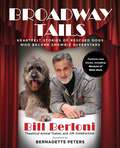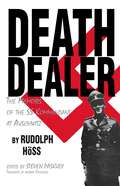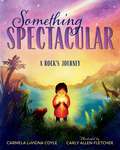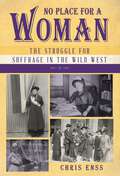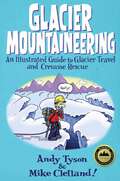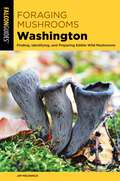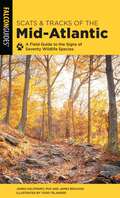- Table View
- List View
Lefty Kreh's Fly Fishing in Salt Water
by Lefty KrehLefty Kreh&’s original edition of Fly Fishing in Salt Water pioneered a new territory for fly fishers. With over thirty thousand copies sold and the content fully updated, revised, and expanded, this third edition is the saltwater fly fisher&’s bible, based on firsthand experience by an acknowledged master. In clear, practical terms and with helpful photographs and line drawings, Lefty Kreh's Fly Fishing in Salt Water treats the techniques needed to catch all the major saltwater species—bonefish, tarpon, striped bass, bluefish, salmon, permit, snook, sharks, cobia, tuna, billfish, and more. The book shows how to fish from boats and how to wade the flats, and fully explains all the tackle needed and how to use it for specific jobs—the rods, the lines and leaders, and the flies (shown in full color). Lefty provides superb advice about how to make the long casts necessary for fishing the fly in salt water, how to "tease" sailfish and other large fish to within fly-casting range, how to chum, and how to tie the necessary knots for saltwater fishing. Chapter topics include Knots and Leaders, Flies, Tackle, Inshore Fly Fishing, and Boats.
Crochet Messy Bun Hats: 12 Quick and Easy Designs for Looking Good While Keeping Out the Cold
by Kristi SimpsonSecure your hair in a messy bun, slide on your hat, and you are out the door in style!Love warm winter hats but struggle to make them work with a ponytail or quick bun? Crochet messy bun hats are the answer! These hats have a hole at the top for a bun or ponytail to slip through--no more odd bump in your hat. With more coverage than a headband, messy bun hats are the perfect solution for your carefree style! A variety of interesting yet easy stitch patterns in medium-weight solid and self-striping yarns make these hats quick and entertaining to crochet. Each pattern includes gorgeous photos of the finished piece and row-by-row instructions. Make a variety of styles and colors for yourself and to give as gifts. You'll find these hats as delightful to wear as they are to crochet!
Stop Here, This is the Place
by Susan ConleyWinky Lewis and Susan Conley, a photographer and a writer in Portland, tried an experiment. At the startof every week for a year, Winky sent Susan a photograph: of their children, of the street where they liveas neighbors, and of other green places in Maine. By the end of that week Susan sent a tiny story backthat talked to the photograph. Stop Here, This Is The Place tells the story of a year in which children'sarms and legs get longer, and traces of babyhood fade--a year that feels interminable to a ten-year-oldlooking forward and fleeting to that ten-year-old&’s mother, who can always stop here, go back andremember. This delightfully evocative gift book is a reminder to stop and enjoy the precioustime we have with our kids while we have them. Through Susan's recollections of moments from her childhood and the ongoing lives of her children, we&’re reminded of our own childhoods, and of the necessity to stop and pay attention, to hold on.
Best Easy Bird Guide Acadia National Park: A Field Guide to the Birds of Acadia National Park (Birding Series)
by Randi Minetor Nic MinetorBirdwatching is for everyone. No other outdoor pursuit yields so much knowledge of nature&’s ways with so little effort—if one knows what to look for. Best Easy Bird Guide Acadia National Park opens the world of birding to the novice and expert in this complete guide to getting the most out of birding in Acadia National Park. Best Easy Bird Guide Acadia National Park includes sections on birding technology, equipment, identification techniques, birding &“by ear,&” where to view birds, field guides, optics, and other essentials to get birders of all skill levels into the field to identify birds throughout Acadia National Park. Especially valuable are descriptions of habitat, feeding, nesting, and migration—informing the reader not only about what kind of bird is on the other end of the binoculars, but what it is up to as well.Includes:GPS coordinates for each species of the top three to five locations where you&’re likely to see the bird and what time of year is best for thisFull-color photos
Spooky Michigan: Tales of Hauntings, Strange Happenings, and Other Local Lore (Spooky)
by S. E. SchlosserPull up a chair or gather round the campfire and get ready for twenty-five creepy tales of ghostly hauntings, eerie happenings, and other strange occurrences in Michigan. Set in Michigan&’s historic towns and sparsely populated backwoods, the stories in this entertaining and compelling collection will have you looking over your shoulder again and again. Michigan folklore is kept alive in these expert retellings by master storyteller S. E. Schlosser, and in artist Paul Hoffman&’s evocative illustrations. You&’ll hear otherworldly voices and things that go bump in the night, and feel an icy wind on the back of your neck on a warm summer evening. Whether read around the campfire on a dark and stormy night or from the backseat of the family van on the way to grandma&’s, this is a collection to treasure.
100 Turning Points in American History
by Alan AxelrodArnold J. Toynbee, the most famous professional historian of the twentieth century, is widely quoted as having declared that &“History is just one damn thing after another.&” This book argues that history is not about &“things&” at all but is all about turning points—the decisions, acts, innovations, errors, ideas, successes, and failures on which the shape of a nation&’s life—our lives—depends. It presents the 100 points at which America&’s path decisively turned on its way to where we find ourselves today. ● Columbus arrives in the New World● The first slaves arrive in America ● Independence is declared ● Female suffragists meet in Seneca Falls● Fort Sumter falls● A transcontinental railroad is completed● Edison lights his first electric lamp● FDR offers a &“New Deal&” ● The B-29 Enola Gay drops an atomic bomb on Hiroshima● Neil Armstrong sets foot on the moon● President Nixon creates the EPA● 9/11 … Obama … Sandy Hook … Russian election &“meddling&” … the Age of Trump … These and many more are the crucial &“plot points&” in our grand national story, and best-selling historian Alan Axelrod presents them here.
Conquering the Electron: The Geniuses, Visionaries, Egomaniacs, and Scoundrels Who Built Our Electronic Age
by Eric Brach Derek CheungConquering the Electron offers readers a true and engaging history of the world of electronics, beginning with the discoveries of static electricity and magnetism and ending with the creation of the smartphone and the iPad. This book shows the interconnection of each advance to the next on the long journey to our modern-day technologies. Exploring the combination of genius, infighting, and luck that powered the creation of today's electronic age, Conquering the Electron debunks the hero worship so often plaguing the stories of great advances. Want to know how AT&T&’s Bell Labs developed semiconductor technology—and how its leading scientists almost came to blows in the process? Want to understand how radio and television work—and why RCA drove their inventors to financial ruin and early graves? Conquering the Electron offers these stories and more, presenting each revolutionary technological advance right alongside blow-by-blow personal battles that all too often took place.
Spooky Massachusetts: Tales of Hauntings, Strange Happenings, and Other Local Lore (Spooky)
by S. E. SchlosserWhat better locale to consider for spooky happenings than the home of the Salem witch trials? From mysteries at sea to ghosts and unexplained footprints, you'll shiver your way through these mesmerizing tales. Set in the state's historic towns, charming old islands, and sparsely populated backwoods, the stories in this entertaining and compelling collection are great for the whole family.
Happy Birthday, Maine
by Lynn PlourdeMaine is turning 200 and Paul Bunyan and his friend Moose want to throw a party as big as they are. With the help of their friends they plan a spectacular bash and invite every Mainer, as well as anyone from away who would like to attend. Culminating in a grand celebration, this book, weaving in elements of Maine facts and history, is itself a bicentennial celebration of Maine that will help the youngest readers come to love this special place.
The Fort Restaurant Cookbook: New Foods of the Old West from the Landmark Colorado Restaurant
by Holly Arnold KinneyThe Fort Cookbook…. a celebration of New Foods of the Old West.Constructed as a family home and then living history museum in 1961, the adobe Fort was built to emulate the frontier trading posts of the nineteenth century. Taking its cues from the architecture and the foods of the Southwest, the building and the menu hearken back to an earlier time while providing patrons with a modern and elegant dining experience.This cookbook is a celebration of The Fort with more than150 favorite recipes developed throughout its fifty-eight-year history, including some from its most recent menus, and sixty-five full-color recipe photos. The Fort was an early proponent of locavore food and features regional game recipes, which brings additional appeal to this celebratory cookbook and memento. Some of the new and most popular recipes in this cookbook include Thomas Jefferson&’s Green Chile Mac & Cheese Savory &“Pudding&”; Marinated Rack of Lamb with Couscous; and Mexican Chocolate Ice Cream Mud Pie.
The Course of Irish History
First published over forty years ago and now updated to cover the &“Celtic Tiger&” economic boom of the 2000s and subsequent worldwide recession, this new edition of a perennial bestseller interprets Irish history as a whole. Designed and written to be popular and authoritative, critical and balanced, it has been a core text in both Irish and American universities for decades. It has also proven to be an extremely popular book for casual readers with an interest in history and Irish affairs. Considered the definitive history among the Irish themselves, it is an essential text for anyone interested in the history of Ireland.
Best Hikes Phoenix: The Greatest Views, Wildlife, and Desert Strolls (Best Hikes Near Series)
by Bruce GrubbsBest Hikes Near Phoenix details 40 of the best hikes within an hour's drive of the greater Phoenix area, including outings near Tempe, Mesa, Scottsdale, Chandler, and Apache Junction. Ranging from easy nature walks to strenuous multiday backpack trips, the routes in this guide offer something for every hiker—within easy reach of the city. Each featured hike includes a brief route description, at-a-glance data including the length and difficulty level, thorough directions to the trailhead, directional cues, and a detailed trail map with accurate trail information. Inside you&’ll find:• Full-color photos and maps• GPS waypoints for every hike• Water availability, land status, fees and permits required, and more• Sidebars on local lore, plants, and animals
Rings of Fire: How an Unlikely Team of Scientists, Ex-Cons, Women, and Native Americans Helped Win World War II
by Larry J. Hughes&“An epic story, filled with an unfolding array of evocatively described landscapes and sharply drawn, unforgettable people.&”—Dayton Duncan, writer and producer for Ken Burns documentary films and author of fourteen books on American history and national parksEdwin Land had barely settled into his seat on the plane when the flash went off. An idea for an innovative WWII technology that might help eradicate the fascist cancer devouring the free world. It was Polaroid&’s Optical Ring Sight, which magically projected a bullseye of brilliantly colored rings onto the sky—like rings of fire—to aim American antiaircraft guns that previously &“couldn&’t hit the broad side of a barn.&”Rings of Fire is the compelling story of American ingenuity, determination, and grit—told through the personal stories of the amazing people who transformed insight into gunsight. From scientists to ordinary Americans to drifters and ex-cons characterized as &“the underbelly of America,&” they crossed cultural barriers to tackle a shared crisis:California &“desert rat&” artist, John Hilton, whose mining claim supplied the calcite crystals desperately needed for the device, assisted by Gen. George S. Patton.Miners Steve Modesto and John Owens, a Cahuilla Indian ranch hand and a white meat-cutter from Kansas, whose friendship led to an astonishing discovery.Moonshiner Al Hansen, whose calcite prospecting in Montana started with a lucky strike but cascaded into a wild-west vigilante showdown.&“Crystal Crackin&’ Mama&” Irene Frederick, whose calcite-crystal processing skills silenced male skeptics and helped rescue the Polaroid project from disaster.Edwin Stanton, whose hubris led to a fat FBI dossier and tragedy while prospecting in Mexico.Cecil Kegans, a rough Oklahoman with a huge smile, starting his Marine career by fetching groceries for calcite miners and ending it in a bloody pool on Saipan.And miner Harry Sikkenga, whose fist fight with a shift boss packed him off to the army artillery, just in time to invade Germany and encounter the horror of Dachau. Teamed together, they overcame enormous personal obstacles to produce ring sights for Navy ships, aircraft, and Army bazookas. And afterwards, their product went from aiming the guns of war to the cameras of peacetime—for television and on the helmets of skydiving videographers. And then, all the way to the moon, aiming NASA&’s space cameras, culminating with perhaps the most influential photograph of all time, Earthrise.Larry Hughes unfolds this gripping, never-told story with accessible explanations of the science and the art behind the project, but always lets the colorful characters drive a warm and vivid adventure.
The Barstool Book of Sports: Stats, Stories, and Other Stuff for Drunken Debate
by Andrew DanielsSports debates are the foundation of every fan&’s night out. But it&’s not enough merely to have these inebriated arguments—you must win them, too. Enter The Barstool Book Of Sports: a disorderly debate bible that&’s jam-packed with hilarious lists, irreverent sidebars, and edgy illustrations that will help you transform your sports knowledge and sound smarter and more confident than everyone else in drunken trivia duels—even when you can&’t see straight. Forget boring &“Player X vs. Player Y&” fights. This book tackles the hard-hitting stuff: Who are the best fat athletes of all time? Where&’s the saddest fan base in America? What are the dumbest athlete injuries ever? Which nonsensical sports conspiracy is just plausible enough to actually be true? Which NFL player should star alongside CGI animals in the football version of Space Jam? Consider it the ultimate toast to every intoxicated argument you&’ve ever had.
Medicina en Zonas Silvestres NOLS (NOLS Library)
by Tod SchimelpfenigThis vital resource for outdoor enthusiasts is now available for the first time in Spanish. Learn how to prevent, recognize, and treat common medical problems and to stabilize a severely ill or injured patient for evacuation.
Hiking the Gulf Coast: A Guide to the Area's Greatest Hiking Adventures (Regional Hiking Series)
by Joe CuhajHiking the Gulf Coast highlights the 40 best hikes in the &“Third Coast&” region, from easy to more moderate and difficult. The book spans Florida, Alabama, Mississippi, Louisiana, and Texas. Complete with full-color and maps throughout, this is a must-have hiking guide to the area.
Broadway Tails: Heartfelt Stories of Rescued Dogs Who Became Showbiz Superstars
by Bill BerloniThe sun always comes out tomorrow for the shelter animals Bill Berloni rescues—sometimes from death&’s door—and then trains to meet the demands of the stage. Berloni was a nineteen-year-old theater apprentice more then three decades ago when he was offered his first big break: find and train a dog to appear in the original production of the Broadway hit Annie. Defying the odds, he rescued a down-on-his-luck dog from a local shelter and, together, they redefined what animal performers could do. Since then Berloni and his trainers have provided animals for hundreds of films, commercials, and television shows as well as live theater, including productions of The Wizard of Oz and Winn-Dixie, all over North America. In this heartwarming book, he tells the true stories of &“throw-away&” animals who came back to work with some of entertainment&’s biggest names, names like Bernadette Peters, Sarah Jessica Parker, Mike Nichols, the New York City Ballet, and many more. This updated edition includes an account of Berloni&’s search for the newest Sandy to star with everyone&’s favorite red-headed orphan.
Death Dealer: The Memoirs of the SS Kommandant at Auschwitz
by Rudolf HossBy his own admission, SS Kommandant Rudolf Hess's was history's greatest mass murderer, having personally supervised the extermination of approximately two million people, mostly Jews, at the death camp in Auschwitz, Poland. Death Dealer is the first complete translation of Hess's memoirs into English. These bone-chilling memoirs were written between October 1946 and April 1947. At the suggestion of Professor Sanislaw Batawia, a psychologist, and Professor Jan Shen, the prosecuting attorney for the Polish War Crimes Commission in Warsaw, Hess wrote a lengthy and detailed description of how the camp developed, his impressions of the various personalities with whom he dealt, and even the extermination of millions in the gas chambers. This written testimony is perhaps the most important document attesting to the Holocaust, because it is the only candid, detailed, and (for the most part) honest description of the Final Solution from a high-ranking SS officer intimately involved in carrying out the plans of Hitler and Himmler. With the cold objectivity of a common hit-man, Höss chronicles the discovery of the most effective poison gas, and the technical obstacles that often thwarted his aim to kill as efficiently as possible. Staring at the horror without reacting, Hess allowed conditions at Auschwitz to reduce human beings to walking skeletons - then he labelled them as subhumans fit only to die. Readers will witness Hess's shallow rationalizations as he tries to balance his deeds with his increasingly disturbed, yet always ineffectual, conscience.
Something Spectacular: A Rock's Journey
by Carmela CoyleHave you ever held a rock in your hand and wondered:How did this come to be?Carmela LaVigna Coyle&’s new picture book takes readers on an epic journey through time. Through ice ages, meteor showers, and earthquakes, readers experience the formation of an ancient treasure. Meanwhile, somewhere in the present, a little girl sets out on a hike with her family.The two parallel stories collide when the little girl finds something SPECTACULAR on the side of a trail—a treasure forged over the course of hundreds of MILLIONS of years all leading to this very moment—the discovery of a precious heart rock.Illustrated with Carly Allen-Fletcher's lush and vivid paintings, Something Spectacular is a geologic adventure with heart and wonder. The perfect book for rockhounds young and old.
No Place for a Woman: The Struggle for Suffrage in the Wild West
by Chris EnssIn 1869, more than twenty years after Elizabeth Cady Stanton and Susan B. Anthony made their declaration of the rights of woman at Seneca Falls, New York, the men of the Wyoming Territorial Legislature granted women over the age of 21 the right to vote in general elections. And on September 6, 1870, a grandmother named Louisa Ann Swain stepped up to a ballot box in Laramie, Wyoming, and became the first woman in the United States to exercise that right, ushering in the era of Western states&’ early foray into suffrage equality. Wyoming Territory&’s motives for extending the vote to women might have had more to do with publicity and attracting female settlers than with any desire to establish a more egalitarian society. However, individual men&’s interests in the idea of women&’s rights had their roots in diverse ideologies, and the women who agitated for those rights were equally diverse in their attitudes.No Place for a Woman explores the history of the fight for women&’s rights in the West, examining the conditions that prevailed during the vast migration of pioneers looking for free land and opportunity on the frontier, the politics of the emerging Western territories at the end of the Civil War, and the changing social and economic conditions of the country recovering from war and on the brink of the Gilded Age. The stories of the women who helped settle the West and who ushered in voting rights decades ahead of the 19th Amendment and the stories of the country they were forging in the West will be of great interest to readers as the 100th anniversary of national woman suffrage approaches and is relevant in our current political climate. Through the individual stories of women like Esther Hobart Morris, Martha Cannon, and Jeannette Rankin, this book fills a hole in the story of the West, revealing the real story of how the hard work and individual lobbying of a few heroines, plus a little bit of publicity-seeking and opportunism by promoters of the Wyoming Territory, ushered in a new era for the expansion of women&’s rights.
Glacier Mountaineering: An Illustrated Guide to Glacier Travel and Crevasse Rescue (How To Climb Series)
by Andy TysonGlacier Mountaineering provides the knowledge and skills needed to safely and self-sufficiently navigate over glacier terrain. Hundreds of hilarious and helpful illustrations by Mike Clelland complement the clear and concise text by Andy Tyson. Providing critical instruction for anyone planning to travel over glacier country—from the Cascades to the Rockies to Denali—this book will guide and entertain readers through glacier anatomy, equipment, route finding, and rescue techniques.
Lighthouses of New England: From Maine to Long Island Sound
by Ray JonesNew England's lighthouses project more than lifesaving beams across treacherous expanses of water. They also project an aura of steadfastness, dependability, and safety--and deservedly so. This guide features descriptions and beautiful photographs of more than sixty lighthouses from Northern Maine to the Long Island Sound.
Crochet Baby Blankets: 13 Easy to Intermediate Designs
by Kristi SimpsonWelcome baby with a beautiful handmade blanket!A crocheted blanket is the perfect gift for a new baby. Putting the time and effort into making your gift bestows a special meaning to it, and favorite blankets are often cherished into toddlerhood and beyond. Many become heirlooms for the next generation. The 13 designs in this book showcase a variety of stitches and techniques, but all are appropriate for a beginner to intermediate skill level. Crochet them in the color palettes shown, or use colors to match the nursery or your own favorite combinations. You'll delight in seeing the stitches fly off your hook as your blanket progresses, and baby and new mom will love snuggle time in the soft, beautiful afghan you made!
Foraging Mushrooms Washington: Finding, Identifying, and Preparing Edible Wild Mushrooms (Foraging Series)
by Jim MeuninckDetailed descriptions of edible mushrooms; tips on finding, preparing, and using mushrooms; a glossary of botanical terms; color photos. Use Foraging Mushrooms Washington as a field guide or as a delightful armchair read. No matter what you&’re looking for, be it the curative Heal-All or a snack, this guide will enhance your next backpacking trip or easy stroll around the garden, and may just provide some new favorites for your dinner table.
Scats and Tracks of the Mid-Atlantic: A Field Guide To The Signs Of Seventy Wildlife Species (Scats and Tracks Series)
by James Halfpenny Jim BruchacSee those animal signs on the trail? Was that footprint left by a fox or a wolf? Was that pile of droppings deposited by a moose, a mouse, or a marten? Scats and Tracks of the Mid-Atlantic will help you determine which mammals, birds, reptiles, and amphibians have passed your way and could still be nearby. Clearly written descriptions and illustrations of scats, tracks, and gait patterns will help you recognize species across Pennsylvania, Delaware, Maryland, Virginia, West Virginia, and North Carolina. An identification key, a glossary of tracking terms, and detailed instructions on how to document your finds are also included here. Easy-to-use scat and track measurements appear on each page, making this book especially field friendly and letting you know if a white tailed ptarmigan, a red fox, or even a black bear has been your way.
